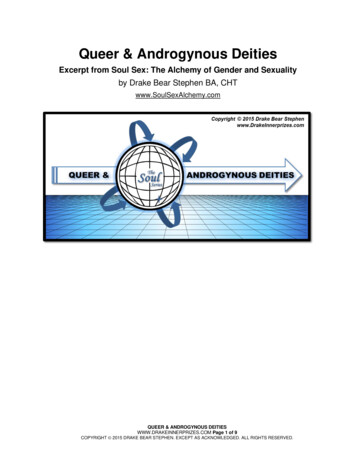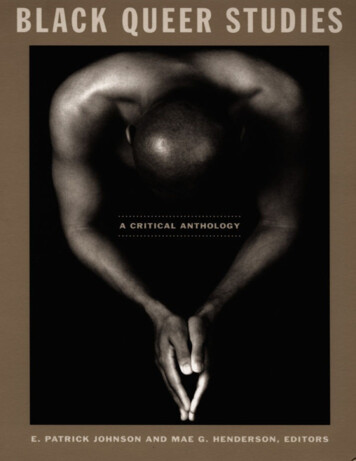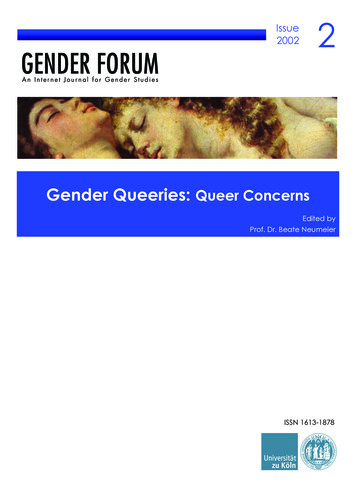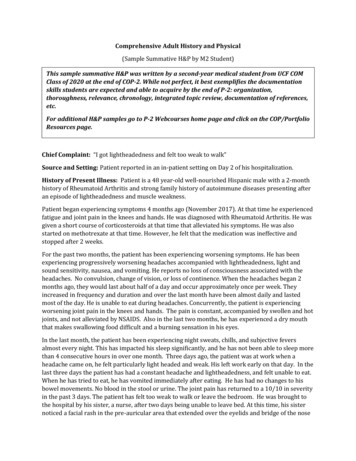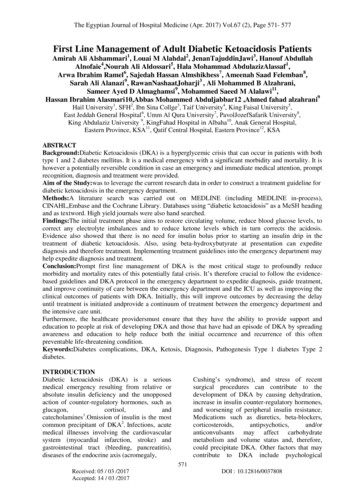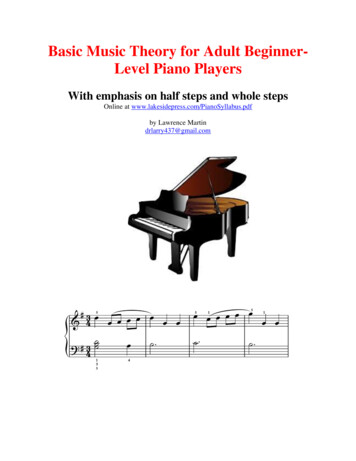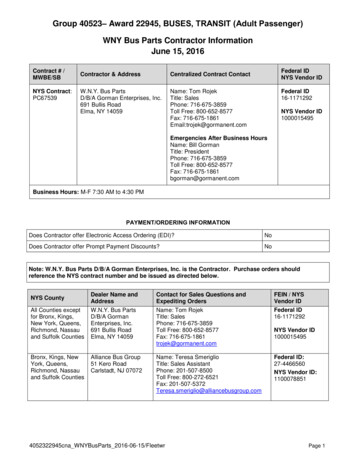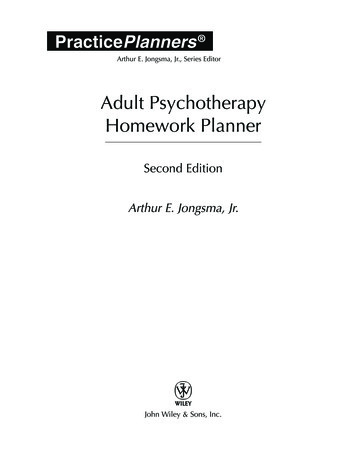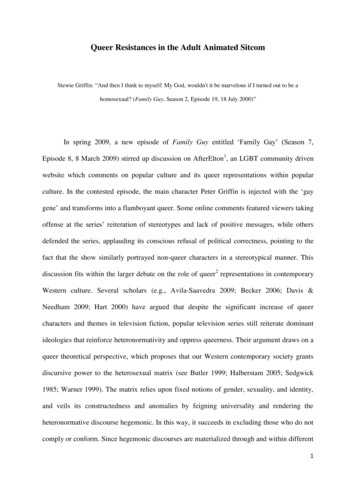
Transcription
Queer Resistances in the Adult Animated SitcomStewie Griffin: ―And then I think to myself: My God, wouldn't it be marvelous if I turned out to be ahomosexual? (Family Guy, Season 2, Episode 19, 18 July 2000)‖In spring 2009, a new episode of Family Guy entitled ‗Family Gay‘ (Season 7,Episode 8, 8 March 2009) stirred up discussion on AfterElton1, an LGBT community drivenwebsite which comments on popular culture and its queer representations within popularculture. In the contested episode, the main character Peter Griffin is injected with the ‗gaygene‘ and transforms into a flamboyant queer. Some online comments featured viewers takingoffense at the series‘ reiteration of stereotypes and lack of positive messages, while othersdefended the series, applauding its conscious refusal of political correctness, pointing to thefact that the show similarly portrayed non-queer characters in a stereotypical manner. Thisdiscussion fits within the larger debate on the role of queer2 representations in contemporaryWestern culture. Several scholars (e.g., Avila-Saavedra 2009; Becker 2006; Davis &Needham 2009; Hart 2000) have argued that despite the significant increase of queercharacters and themes in television fiction, popular television series still reiterate dominantideologies that reinforce heteronormativity and oppress queerness. Their argument draws on aqueer theoretical perspective, which proposes that our Western contemporary society grantsdiscursive power to the heterosexual matrix (see Butler 1999; Halberstam 2005; Sedgwick1985; Warner 1999). The matrix relies upon fixed notions of gender, sexuality, and identity,and veils its constructedness and anomalies by feigning universality and rendering theheteronormative discourse hegemonic. In this way, it succeeds in excluding those who do notcomply or conform. Since hegemonic discourses are materialized through and within different1
societal institutions, including the media industries, popular culture also perpetuatesheteronormative ideals.Recently, animated sitcoms have begun to incorporate queer characters and queerthemes. For instance, The Simpsons legalizes gay marriage in ‗There‘s Something AboutMarrying‘ (Season 16, Episode 10, 20 February 2005), American Dad discusses same-sexadoption in ‗Surro-Gate‘ (Season 3, Episode 7, 2 December 2007), and King of The Hillbrings the coming-out story of a character‘s father in ‗My Own Private Rodeo‘ (Season 6,Episode 18, 28 April 2002). In accordance with queer media theory‘s critique of popularculture‘s reiterations of heteronormativity, the representation of queer themes or charactersdoes not per se defy the heterosexual norm. Jeffery P. Dennis (2003, 137) stresses thatcontemporary animated series only portray tolerance towards a queer identity while thecontext often remains that of hegemonic heterosexual desire. Yet Stuart Hall (2005, 71)argues that popular culture cannot be regarded as only reiterating hegemonic discourses.Because of its ability to function as a site where production, text, and reception interact, andmeaning is constantly renegotiated, popular culture—particularly television—is part of both astruggle for and against hegemonic discourses. Hall thus implies that popular culture canembed articulations of resistance, or, because of the potential polysemy of texts, can be readagainst the grain. Both strategies allow using the popular as a means to expose themechanisms and inconsistencies of discourses on the one hand and to offer viable alternativesto the heteronormal on the other.With this article, we want to point out how the adult animated sitcom articulatesinstances of queer resistance. The genre is characterized by its mixture of animation andtraditional sitcom conventions. It draws on the established genre conventions, but usespostmodern textual strategies to transcend genre boundaries, criticize and/or mock2
contemporary popular culture, and target both young and adult audiences. In this regard,Simone Knox (2006, 73) argues that adult animated series like Family Guy are marked with acertain ―double-codedness‖, since they are commercially viable and hugely popular3 whilebeing critically praised for their often blatant satire or subversiveness. She draws on LindaHutcheon (2002, 11), who looks upon postmodern culture as articulating complicity andcritique, thus inscribing and subverting dominant conventions and ideologies at once. Withregard to this duplicity, Hutcheon (2002, 23, 178-79) and Max H. Kirsch (2000, 28-31)underscore the similarities in objectives and strategies of queer and postmodern practices.They argue that even though both practices refrain from offering a straightforward theory ofagency, they nonetheless unsettle, expose, and subvert normative discursive practices byrelying on irony and parody. Hence, these practices are predominantly occupied withdeconstructing hegemonic discourses. We thus argue that a study on the adult animatedsitcom‘s articulations of queer resistance needs to be discussed from a perspective thatincorporates the genre‘s postmodern textual strategies. To this end, we conducted a textualthematic analysis of five episodes of Family Guy that feature queer characters and/or themes.This case study functions as both an illustration and exploration of the potentialities and limitsof queer resistance within this postmodern genre.Pastiche, Parody and the Adult Animated SitcomEver since The Simpsons (1989-) went on the air, the adult animated sitcom genre hasgained international success with popular series such as King Of The Hill (1997- ), South Park(1997-), Daria (1997-2002), Family Guy (1999- ), and American Dad (2005- ). Clearly, thegenre has achieved a prominent spot in contemporary Western popular culture. The Simpsonshas succeeded in re-establishing animation as a prime-time genre, since the early 1960s boom3
in prime-time animation headed by The Flintstones (1959-1966) and other series by HannaBarbera Productions failed to maintain drawing major audiences (Booker 2006, ix-xii; HiltonMorrow & McMahan 2003, 77-78). The Simpsons set the tone for knock-offs to come bycreating a postmodern genre that satirizes suburban life and presents itself as a parody ofAmerican popular culture, and in particular of the archetypical family sitcom (Booker 2006,48). On the surface, these animated sitcoms remain true to the generally appraised image ofthe American neurotic middle-class family. But at the same time, the concept of family isused to subvert many (hetero-)normative values. The genre joins in a range of comedictelevision series (e.g., Married With Children (1987-1997), Modern Family (2009-)) thatshare the urge to ‗laugh‘ at the impossibility of traditional images that were being portrayed inarchetypical family sitcoms. However, the genre‘s subversive take on the family differs fromthe enacted comedic series‘ approach, since the latter is predominantly shaped by codes ofrealism and naturalism. The adult animated sitcom relies on animation, which makes itpossible to push the boundaries further when it comes to portraying subversive views (Tueth2003, 139-41). According to Jonathan Gray (2006), animation has the advantage of creating adistance between audiences and the text that ―softens the blows on the viewer‘s moral sense,highlighting that ‗it‘s only a cartoon‘‖ (p. 67). Yet he considers that animation gives parodymore options to formulate critique because the potential of exaggeration and literalizationincreases and the social and cultural verisimilitude can easily be transgressed. Further, takinginto account that the genre frequently employs intertextuality as a representational strategy,animation enables infinite intertextual representations. Since intertextuality provokes thetextual dominance of hegemonic discursive meanings and defies the exclusion of resistant oroppositional meanings, it ensures the genre‘s potential to question the discursive power ofhegemonic discourses (Gray 2006, 39-40, 66).4
The interplay of postmodern strategies and the animated aesthetic can result inparodies resistant to dominant institutions, practices, norms and values. Hence, we cannotagree with Fredric Jameson‘s (2006) critical statement that parody has been replaced bypastiche in a postmodern era. He postulates that postmodern culture is, most of all, a cultureof pastiche, characterized by a refusal or neglect to diverge from or oppose norms andconventions. He considers it to be ‗blank parody‘ because it mimics and imitates the past but―without any of parody‘s ulterior motives, amputated of the satiric impulse, devoid of laughterand of any conviction that alongside the abnormal tongue you have momentarily borrowed,some healthy linguistic normality still exists‖ (p. 493). Since Gray (2006, 5-109) argues thatThe Simpsons incorporates both moments of pastiche and significant parody, andacknowledges the series‘ critical potential, we are inclined to follow Hutcheon (2002) whoconsiders parody to be central to postmodernism. In contrast to Jameson, she argues thatparody is a reprise of the past articulated through a critique. She stresses that parody is aboutshowing how current representations derive from past ones, and articulating its complicity tothe past by continuing representational conventions, and its critique to the past by subvertingthese conventions (Hutcheon 2002, 89).The adult animated sitcom applies both techniques of parody and pastiche centrally,since this genre not only engages in parody but also uses pastiche to affect audiences, whetherby evoking reflection or laughter. Particularly adult animated series use the postmodern as ameans for comedy (Steeves 2005). Even though comedy has the potency to offer a critique ofnormality through exposing invisible aspects of everyday life and turn them into visibleirrationalities (Gray 2006, 106-07), pleasure can also come from recognizing the original thathas been faithfully mimicked. We therefore agree with Dyer (2007) that pastiche is anaffective articulation which ―allows us to feel our connection to the affective frameworks, the5
structures of feeling, past and present, that we inherit and pass on‖ (p. 180). Pastiche, likeparody, thus sets up a relation to the past and makes explicit how feelings and thoughts arealways dependent upon the frameworks available in a certain time and place. Parody andpastiche thus both aid in creating a site for deconstructing discourses through reinstating andsubverting them, rather than actively and blatantly articulating political strategies of agency orformulating straightforward counter-discourses.Looking for Queer DeconstructionsSince the adult animated sitcom is situated at the crossroads between complicity,questioning, and critique, the genre does not offer concrete political stances or transgressivecounter-discourses. However, as argued before, its critical value resides in the intertextualprovocations and subversions that deconstruct universalized notions of hegemonic discourses.In this article, deconstruction will be discussed as a form of queer resistance. Because queertheory is largely indebted to post-structuralism, deconstruction is at the core of queertheoretical enterprises (Seidman 1995, 125-31). Deconstructive analysis can resist discoursesof heteronormativity and homosexuality, by exposing how they construct fixed andoppositional gender and sexual identities, and consolidate heteronormative hierarchies. Inparticular queer deconstructions look at contradictions and frictions in identity articulations,and focus on the margins to critically assess the heteronormative centre. On the other handscholars who employ queer deconstructive analysis recognize that a text is polysemic and thusopens up different reading positions. According to Alexander Doty (2000, 1-3), popularculture products incorporate as much queerness as they incorporate straightness. The onlydifference between both is that the queer reading is not the preferred reading. Doty stressesthe importance of sharing these alternative readings to broaden our shared knowledge of6
interpretations of the same text. However, aside from lending its strategies to queer readingpractices, deconstruction can also function as a strategy of representation. Queer resistance isthen articulated in queer themes and/or characters and exposes or disrupts normative patternsand notions from within. Particularly, in the adult animated sitcom, the contradictions andfrictions concerning gender and sexuality are explicated by the genre‘s postmodern textualstrategies, such as exaggeration, literalization, or intertextuality, whether or not intended aspastiche or parody. In addition the genre benefits from the unique ability of animation, asSean Griffin (2004, 106-08) rightly points out, to easily unsettle gender and sexual categoriesby its frequent use of metamorphosis or parodic redeployment. These deconstructions thenfunction as textual disruptions, exposing heteronormativity rather than offering a queerpolitical agenda.Even though many of the contemporary animated sitcoms are suitable for a thoroughinquiry of deconstructionist instances of queer resistance4, we chose to solely look intoFamily Guy. The series, created by Seth McFarlane, has become a competitor to the yellowempire of The Simpsons. Like The Simpsons, it features an all-American suburban middleclass family, the Griffin family, which includes a working father (Peter Griffin), a stay-athome mother (Lois Griffin), three children (Meg, Chris, and Stewie Griffin) and a family pet(Brian). However, Family Guy places less emphasis on narrative storylines than TheSimpsons, adds surreal identity traits to some of its characters, while at the same timeembedding them into a contemporary reality. Furthermore, its display of sexual taintedhumor, political incorrectness, and bigotry has led the series into a realm of controversy anddebate that has fast surpassed any surrounding The Simpsons (Needham 2009,
In spring 2009, a new episode of Family Guy entitled ‗Family Gay‘ (Season 7, Episode 8, 8 March 2009) stirred up discussion on AfterElton1, an LGBT community driven website which comments on popular culture and its queer representations within popular culture. In the contested episode, the main character Peter Griffin is injected with the ‗gay gene‘ and transforms into a flamboyant queer. Some online

